Ismail al-Jazari
Badīʿ az-Zaman Abu l-ʿIzz ibn Ismāʿīl ibn ar-Razāz al-Jazarī (1136–1206, Arabic: بديع الزمان أَبُ اَلْعِزِ إبْنُ إسْماعِيلِ إبْنُ الرِّزاز الجزري, IPA: [ældʒæzæriː]) was a Muslim polymath: a scholar, inventor, mechanical engineer, artisan, artist and mathematician from Jazira in Mesopotamia. He is best known for writing The Book of Knowledge of Ingenious Mechanical Devices (Arabic: كتاب في معرفة الحيل الهندسية, romanized: Kitab fi ma'rifat al-hiyal al-handasiya, lit. 'Book in knowledge of engineering tricks') in 1206, where he described 100 mechanical devices, some 80 of which are trick vessels of various kinds, along with instructions on how to construct them. He is credited with the inventions of the flush toilet and the elephant clock.[2]
Ismail al-Jazari | |
|---|---|
| Title | al-Jazari |
| Personal | |
| Born | 1136 CE |
| Died | 1206 CE |
| Religion | Islam |
| Era | Islamic Golden Age |
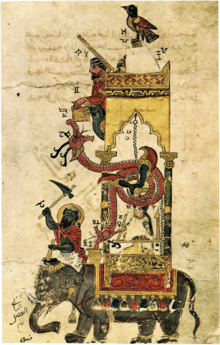
Biography
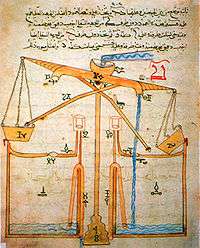
Al-Jazari was born in the area of Upper Mesopotamia in 1136. Sources state his exact location is unknown, but they speculate he could have been born in Jazirat ibn Umar, where he got the name Jazari from or Al-Jazira which was used to denote Upper Mesopotamia.[3][4][5] The only biographical information known about him is contained in his Book of Knowledge of Ingenious Mechanical Devices.[6] Like his father before him, he served as chief engineer at the Artuklu Palace, the residence of the Mardin branch of the Artuqids which ruled across eastern Anatolia as vassals of the Zengid dynasty of Mosul and later of Ayyubid general Saladin.[7]
Al-Jazari was part of a tradition of artisans and was thus more a practical engineer than an inventor[8] who appears to have been "more interested in the craftsmanship necessary to construct the devices than in the technology which lay behind them" and his machines were usually "assembled by trial and error rather than by theoretical calculation".[9] His Book of Knowledge of Ingenious Mechanical Devices appears to have been quite popular as it appears in a large number of manuscript copies, and as he explains repeatedly, he only describes devices he has built himself. According to Mayr, the book's style resembles that of a modern "do-it-yourself" book.[10]
Some of his devices were inspired by earlier devices, such as one of his monumental water clocks, which was based on that of a Pseudo-Archimedes.[11] He also cites the influence of the Banū Mūsā brothers for his fountains, al-Saghani for the design of a candle clock, and Hibatullah ibn al-Husayn (d. 1139) for musical automata. Al-Jazari goes on to describe the improvements he made to the work of his predecessors, and describes a number of devices, techniques and components that are original innovations which do not appear in the works by his precessors.[12]
Mechanisms and methods
The most significant aspect of al-Jazari's machines are the mechanisms, components, ideas, methods, and design features which they employ.[7]
Camshaft
A camshaft, a shaft to which cams are attached, was introduced in 1206 by al-Jazari, who employed them in his automata,[13] water clocks (such as the candle clock)[14] and water-raising machines.[13] The cam and camshaft also appeared in European mechanisms from the 14th century.[15]
Crankshaft and crank-slider mechanism
The eccentrically mounted handle of the rotary quern-stone in fifth century BCE Spain that spread across the Roman Empire constitutes a crank.[16] The earliest evidence of a crank and connecting rod mechanism dates to the 3rd century AD Hierapolis sawmill in the Roman Empire.[16] The crank also appears in the mid-9th century in several of the hydraulic devices described by the Banū Mūsā brothers in their Book of Ingenious Devices.[17]
In 1206, al-Jazari invented an early crankshaft,[18][19] which he incorporated with a crank-connecting rod mechanism in his twin-cylinder pump.[20] Like the modern crankshaft, al-Jazari's mechanism consisted of a wheel setting several crankpins into motion, with the wheel's motion being circular and the pins moving back-and-forth in a straight line.[18] The crankshaft described by al-Jazari[18][19] transforms continuous rotary motion into a linear reciprocating motion,[20] and is central to modern machinery such as the steam engine, internal combustion engine and automatic controls.[19][21]
He used the crankshaft with a connecting rod in two of his water-raising machines: the crank-driven saqiya chain pump and the double-action reciprocating piston suction pump.[20][22] His water pump also employed the first known crank-slider mechanism.[23]
Design and construction methods
English technology historian Donald Hill writes:
We see for the first time in al-Jazari's work several concepts important for both design and construction: the lamination of timber to minimize warping, the static balancing of wheels, the use of wooden templates (a kind of pattern), the use of paper models to establish designs, the calibration of orifices, the grinding of the seats and plugs of valves together with emery powder to obtain a watertight fit, and the casting of metals in closed mold boxes with sand.[7]
Escapement mechanism in a rotating wheel
Al-Jazari invented a method for controlling the speed of rotation of a wheel using an escapement mechanism.[24]
Mechanical controls
According to Donald Hill, al-Jazari described several early mechanical controls, including "a large metal door, a combination lock and a lock with four bolts".[7]
Segmental gear
A segmental gear is "a piece for receiving or communicating reciprocating motion from or to a cogwheel, consisting of a sector of a circular gear, or ring, having cogs on the periphery, or face."[25] Professor Lynn Townsend White, Jr. wrote:
Segmental gears first clearly appear in al-Jazari, in the West they emerge in Giovanni de Dondi's astronomical clock finished in 1364, and only with the great Sienese engineer Francesco di Giorgio (1501) did they enter the general vocabulary of European machine design.[26]
Water-raising machines
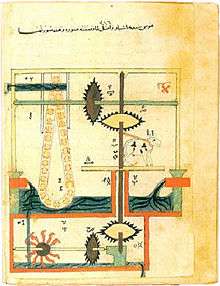
Al-Jazari invented five machines for raising water,[1] as well as watermills and water wheels with cams on their axle used to operate automata,[27] in the 12th and 13th centuries, and described them in 1206. It was in these water-raising machines that he introduced his most important ideas and components.
Saqiya chain pumps
The first known use of a crankshaft in a chain pump was in one of al-Jazari's saqiya machines. The concept of minimizing intermittent working is also first implied in one of al-Jazari's saqiya chain pumps, which was for the purpose of maximising the efficiency of the saqiya chain pump. Al-Jazari also constructed a water-raising saqiya chain pump which was run by hydropower rather than manual labour, though the Chinese were also using hydropower for chain pumps prior to him. Saqiya machines like the ones he described have been supplying water in Damascus since the 13th century up until modern times,[28] and were in everyday use throughout the medieval Islamic world.[29]
Double-action suction pump with valves and reciprocating piston motion
Citing the Byzantine siphon used for discharging Greek fire as an inspiration,[30] al-Jazari went on to describe the first suction pipes, suction pump, double-action pump, and made early uses of valves and a crankshaft-connecting rod mechanism, when he invented a twin-cylinder reciprocating piston suction pump. This pump is driven by a water wheel, which drives, through a system of gears, an oscillating slot-rod to which the rods of two pistons are attached. The pistons work in horizontally opposed cylinders, each provided with valve-operated suction and delivery pipes. The delivery pipes are joined above the centre of the machine to form a single outlet into the irrigation system. This water-raising machine had a direct significance for the development of modern engineering. This pump is remarkable for three reasons:[7][31][32][33]
- The first known use of a true suction pipe (which sucks fluids into a partial vacuum) in a pump.
- The first application of the double-acting principle.
- The conversion of rotary to reciprocating motion via the crank-connecting rod mechanism.
Al-Jazari's suction piston pump could lift 13.6 metres of water, with the help of delivery pipes. This was more advanced than the suction pumps that appeared in 15th-century Europe, which lacked delivery pipes. It was not, however, any more efficient than the noria commonly used by the Muslim world at the time.[34]
Water supply system
al-Jazari developed the earliest water supply system to be driven by gears and hydropower, which was built in 13th century Damascus to supply water to its mosques and Bimaristan hospitals. The system had water from a lake turn a scoop-wheel and a system of gears which transported jars of water up to a water channel that led to mosques and hospitals in the city.[35]
Automata
Al-Jazari built automated moving peacocks driven by hydropower.[36] He also invented the earliest known automatic gates, which were driven by hydropower,[35] created automatic doors as part of one of his elaborate water clocks,[7] and invented water wheels with cams on their axle used to operate automata.[27] According to Encyclopædia Britannica, the Italian Renaissance inventor Leonardo da Vinci may have been influenced by the classic automata of al-Jazari.[37]
Mark E. Rosheim summarizes the advances in robotics made by Muslim engineers, especially al-Jazari, as follows:
Unlike the Greek designs, these Arab examples reveal an interest, not only in dramatic illusion, but in manipulating the environment for human comfort. Thus, the greatest contribution the Arabs made, besides preserving, disseminating and building on the work of the Greeks, was the concept of practical application. This was the key element that was missing in Greek robotic science.[38]
The Arabs, on the other hand, displayed an interest in creating human-like machines for practical purposes but lacked, like other preindustrial societies, any real impetus to pursue their robotic science.[39]
Drink-serving waitress
One of al-Jazari's humanoid automata was a waitress that could serve water, tea or drinks. The drink was stored in a tank with a reservoir from where the drink drips into a bucket and, after seven minutes, into a cup, after which the waitress appears out of an automatic door serving the drink.[40]
Hand-washing automaton with flush mechanism
Al-Jazari invented a hand washing automaton incorporating a flush mechanism now used in modern flush toilets. It features a female humanoid automaton standing by a basin filled with water. When the user pulls the lever, the water drains and the female automaton refills the basin.[41]
Peacock fountain with automated servants
Al-Jazari's "peacock fountain" was a more sophisticated hand washing device featuring humanoid automata as servants which offer soap and towels. Mark E. Rosheim describes it as follows:[38]
Pulling a plug on the peacock's tail releases water out of the beak; as the dirty water from the basin fills the hollow base a float rises and actuates a linkage which makes a servant figure appear from behind a door under the peacock and offer soap. When more water is used, a second float at a higher level trips and causes the appearance of a second servant figure – with a towel!
Musical robot band

Al-Jazari's work described fountains and musical automata, in which the flow of water alternated from one large tank to another at hourly or half-hourly intervals. This operation was achieved through his innovative use of hydraulic switching.[7]
Al-Jazari created a musical automaton, which was a boat with four automatic musicians that floated on a lake to entertain guests at royal drinking parties. Professor Noel Sharkey has argued that it is quite likely that it was an early programmable automata and has produced a possible reconstruction of the mechanism; it has a programmable drum machine with pegs (cams) that bump into little levers that operated the percussion. The drummer could be made to play different rhythms and different drum patterns if the pegs were moved around.[42]
Clocks
Al-Jazari constructed a variety of water clocks and candle clocks. These included a portable water-powered scribe clock, which was a meter high and half a meter wide, reconstructed successfully at the Science Museum in 1976[27][43] Al-Jazari also invented monumental water-powered astronomical clocks which displayed moving models of the Sun, Moon, and stars.
Candle clocks
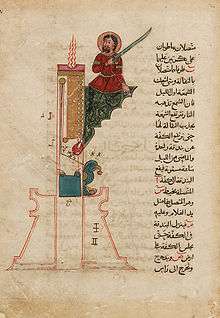
According to Donald Hill, al-Jazari described the most sophisticated candle clocks known to date. Hill described one of al-Jazari's candle clocks as follows:[7]
The candle, whose rate of burning was known, bore against the underside of the cap, and its wick passed through the hole. Wax collected in the indentation and could be removed periodically so that it did not interfere with steady burning. The bottom of the candle rested in a shallow dish that had a ring on its side connected through pulleys to a counterweight. As the candle burned away, the weight pushed it upward at a constant speed. The automata were operated from the dish at the bottom of the candle. No other candle clocks of this sophistication are known.
Al-Jazari's candle clock also included a dial to display the time and, for the first time, employed a bayonet fitting, a fastening mechanism still used in modern times.[44]
Elephant clock
The elephant clock described by al-Jazari in 1206 is notable for several innovations. It was the first clock in which an automaton reacted after certain intervals of time (in this case, a humanoid robot striking the cymbal and a mechanical robotic bird chirping) and the first water clock to accurately record the passage of the temporal hours to match the uneven length of days throughout the year.[45]
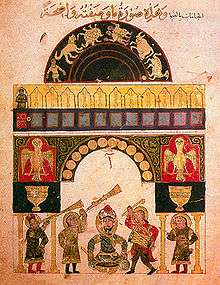
Castle clock
Al-Jazari's largest astronomical clock was the "castle clock", which was a complex device that was about 11 feet (3.4 m) high, and had multiple functions besides timekeeping. It included a display of the zodiac and the solar and lunar orbits, and an innovative feature of the device was a pointer in the shape of the crescent moon which travelled across the top of a gateway, moved by a hidden cart, and caused automatic doors to open, each revealing a mannequin, every hour.[7][46] Another innovative feature was the ability to reprogram the length of day and night in order to account for their changes throughout the year.
Another feature of the device was five automata musicians who automatically play music when moved by levers operated by a hidden camshaft attached to a water wheel.[14] Other components of the castle clock included a main reservoir with a float, a float chamber and flow regulator, plate and valve trough, two pulleys, crescent disc displaying the zodiac, and two falcon automata dropping balls into vases.[47] Al-Jazari's castle clock is considered to be the earliest programmable analog computer.[14]
Weight-driven water clocks
Al-Jazari invented water clocks that were driven by both water and weights. These included geared clocks and a portable water-powered scribe clock, which was a meter high and half a meter wide. The scribe with his pen was synonymous to the hour hand of a modern clock.[27][43] Al-Jazari's famous water-powered scribe clock was reconstructed successfully at the Science Museum, London in 1976.
Miniature paintings
Alongside his accomplishments as an inventor and engineer, al-Jazari was also an accomplished artist. In The Book of Knowledge of Ingenious Mechanical Devices, he gave instructions of his inventions and illustrated them using miniature paintings, a medieval style of Islamic art.
 One of al-Jazari's candle clocks.
One of al-Jazari's candle clocks.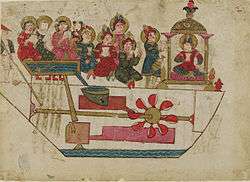 The musical robot band designed by al-Jazari.
The musical robot band designed by al-Jazari. A table device automaton designed by al-Jazari.
A table device automaton designed by al-Jazari. The hand-washing automaton with a flush mechanism designed by al-Jazari.
The hand-washing automaton with a flush mechanism designed by al-Jazari. Al-Jazari's hydropowered saqiya chain pump device.
Al-Jazari's hydropowered saqiya chain pump device. An illustration of a device invented by al-Jazari.
An illustration of a device invented by al-Jazari. A sketch of a device designed by al-Jazari. From the manuscript of Kitabal Al-Hial in Aga Khan Museum, Toronto.
A sketch of a device designed by al-Jazari. From the manuscript of Kitabal Al-Hial in Aga Khan Museum, Toronto.
See also
Notes
- al-Jazari, The Book of Knowledge of Ingenious Mechanical Devices: Kitáb fí ma'rifat al-hiyal al-handasiyya, transl. & anno. Donald R. Hill. (1973), Springer Science+Business Media.
- Beckwith 1997, p. 290.
- Islamic Scientific Thought and Muslim Achievements in Science: Papers Presented. Ministry of Science and Technology, National Hijra Centenary Committee, and Organization of Islamic Conference. 1983.
As the Arabs called upper Mesopotamia **al Jazire" meaning "island", it is quite possible that he was born in this area and therefore referred to as al-Jazari.
- Information, Reed Business (4 April 1974). New Scientist. Reed Business Information.
Born in Upper Mesopotamia in the 12th century ad al-Jazari was employed, from about 1180 onwards, by the rulers of ...
- Meisami, Julie Scott; Starkey, Paul (1998). Encyclopedia of Arabic Literature. Taylor & Francis. ISBN 978-0-415-18571-4.
Born in Jazirat al-'Umar, al-Jazari is most noted as the author of ...
- Marco Ceccarelli, ed. (2010). Distinguished Figures in Mechanism and Machine Science - Part 2. Springer. pp. 1–21. doi:10.1007/978-90-481-2346-9. ISBN 978-90-481-2345-2.
- Donald Hill, "Mechanical Engineering in the Medieval Near East", Scientific American, May 1991, pp. 64-9 (cf. Donald Hill, Mechanical Engineering Archived 25 December 2007 at the Wayback Machine)
- Donald R. Hill, in Dictionary of scientific biography, 15, suppl. I, p. 254.
- Tibbetts, G. R. (1975), "Review: Donald R. Hill, The Book of Knowledge of Ingenious Mechanical Devices (Kitab fi ma'rifat al-hiyal alhandasiyya), by Ibn al-Razzaz al-Jazari", Bulletin of the School of Oriental and African Studies, University of London, 38 (1): 151–153 [152], doi:10.1017/S0041977X00047182
- Otto Mayr (1970), The Origins of Feedback Control, MIT Press, ISBN 0-262-13067-X, pp. 32–33.
- Ahmad Y. al-Hassan, "al-Jazari And the History of the Water Clock" Archived 26 February 2008 at the Wayback Machine
- Banū Mūsā, Donald Hill (1979), The book of ingenious devices (Kitāb al-ḥiyal), Springer, pp. 21–2, ISBN 90-277-0833-9
- Georges Ifrah (2001). The Universal History of Computing: From the Abacus to the Quatum Computer, p. 171, Trans. E.F. Harding, John Wiley & Sons, Inc. (See )
- Ancient Discoveries, Episode 11: Ancient Robots, History, retrieved 6 September 2008
- A. Lehr (1981), De Geschiedenis van het Astronomisch Kunstuurwerk, p. 227, Den Haag. (See odur.let.rug.nl)
- Tullia Ritti, Klaus Grewe, Paul Kessener: "A Relief of a Water-powered Stone Saw Mill on a Sarcophagus at Hierapolis and its Implications“, Journal of Roman Archaeology, Vol. 20 (2007), pp. 138–163 (159)
- A. F. L. Beeston, M. J. L. Young, J. D. Latham, Robert Bertram Serjeant (1990), The Cambridge History of Arabic Literature, Cambridge University Press, p. 266, ISBN 0-521-32763-6
- Sally Ganchy, Sarah Gancher (2009), Islam and Science, Medicine, and Technology, The Rosen Publishing Group, p. 41, ISBN 1-4358-5066-1
- Paul Vallely, How Islamic Inventors Changed the World, The Independent, 11 March 2006.
- Ahmad Y. al-Hassan, The Crank-Connecting Rod System in a Continuously Rotating Machine Archived 12 March 2013 at the Wayback Machine
- Hill 1998, p. 231–232.
- A. F. L. Beeston, M. J. L. Young, J. D. Latham, Robert Bertram Serjeant (1990), The Cambridge History of Arabic Literature, Cambridge University Press, pp. 270–1, ISBN 0-521-32763-6
- Lotfi Romdhane & Saïd Zeghloul (2010), "al-Jazari (1136–1206)", History of Mechanism and Machine Science, Springer, 7: 1–21, doi:10.1007/978-90-481-2346-9, ISBN 978-90-481-2346-9, ISSN 1875-3442
- Donald Hill, "Engineering", in Roshdi Rashed, ed., Encyclopedia of the History of Arabic Science, Vol. 2, pp. 751–795 [792]. Routledge, London and New York.
- Segment gear, TheFreeDictionary.com
- The Automata of Al-Jazari. The Topkapı Palace Museum, Istanbul. Archived 21 April 2003 at the Wayback Machine
- Donald Hill (1996), A History of Engineering in Classical and Medieval Times, Routledge, p. 224
- Ahmad Y. al-Hassan, al-Jazari and the History of the Water Clock Archived 26 February 2008 at the Wayback Machine
- Donald Hill, "Engineering", in Roshdi Rashed, ed., Encyclopedia of the History of Arabic Science, Vol. 2, pp. 751–795 [776]. Routledge, London and New York.
- Hill 2013, p. 150.
- Ahmad Y. al-Hassan. "The Origin of the Suction Pump: al-Jazari 1206 A.D." Archived from the original on 26 February 2008. Retrieved 16 July 2008.
- Hill 2013, pp. 143.
- Hill 2013, p. 150-2.
- Hill 2013.
- Howard R. Turner (1997), Science in Medieval Islam: An Illustrated Introduction, p. 81, University of Texas Press, ISBN 0-292-78149-0
- al-Jazari (Islamic artist), Encyclopædia Britannica.
- "al-Jazari". Encyclopædia Britannica. 2009. Retrieved 4 October 2009.
- Rosheim, Mark E. (1994), Robot Evolution: The Development of Anthrobotics, Wiley-IEEE, p. 9, ISBN 0-471-02622-0
- Rosheim, Mark E. (1994), Robot Evolution: The Development of Anthrobotics, Wiley-IEEE, p. 36, ISBN 0-471-02622-0
- Ancient Discoveries, Episode 12: Machines of the East, History, retrieved 6 September 2008
- Rosheim, Mark E. (1994), Robot Evolution: The Development of Anthrobotics, Wiley-IEEE, pp. 9–10, ISBN 0-471-02622-0
- Professor Noel Sharkey, A 13th Century Programmable Robot (Archive), University of Sheffield.
- Ibn al-Razzaz Al-Jazari (ed. 1974) The Book of Knowledge of Ingenious Mechanical Devices, Translated and annotated by Donald Hill, Dordrecht / D. Reidel, part II.
- Ancient Discoveries, Episode 12: Machines of the East, History, retrieved 7 September 2008
- Hill 1992, pp. 57–59.
- Howard R. Turner (1997), Science in Medieval Islam: An Illustrated Introduction, p. 184. University of Texas Press, ISBN 0-292-78149-0.
- Salim Al-Hassani (13 March 2008). "How it Works: Mechanism of the Castle Clock". FSTC. Retrieved 6 September 2008.
References
- Ulrich Alertz, The Horologium of Hārūn al-Rashīd Presented to Charlemagne – An Attempt to Identify and Reconstruct the Clock Using the Instructions Given by al-Jazarī, in: Zielinski, Siegfried; Fürlus, Eckhard (2010). Variantology: On deep time relations of arts, sciences and technologies in the Arabic-Islamic world and beyond. Distributed Art Pub Incorporated. ISBN 978-3-86560-732-4.CS1 maint: ref=harv (link)
- Beckwith, Guy V. (1 October 1997). Readings in Technology and Civilization. Pearson Custom Publishing. ISBN 978-0-536-00579-3.CS1 maint: ref=harv (link)
- Claus-Peter Haase, Modest Variations—Theoretical Tradition and Practical Innovation in the Mechanical Arts from Antiquity to the Arab Middle Ages, in: Zielinski, Siegfried; Fürlus, Eckhard (2010). Variantology: On deep time relations of arts, sciences and technologies in the Arabic-Islamic world and beyond. Distributed Art Pub Incorporated. ISBN 978-3-86560-732-4.CS1 maint: ref=harv (link)
- al-Hassan, Ahmad Y.; Hill, Donald (1992). Islamic Technology: An Illustrated History. Cambridge University Press. ISBN 978-0-521-42239-0.CS1 maint: ref=harv (link)
- Hill, Donald (2012). The Book of Knowledge of Ingenious Mechanical Devices: (Kitāb fī ma 'rifat al-ḥiyal al-handasiyya). Springer Science & Business Media. ISBN 978-94-010-2573-7.CS1 maint: ref=harv (link)
- Hill, Donald (2013). A History of Engineering in Classical and Medieval Times. Routledge. ISBN 978-1-317-76157-0.CS1 maint: ref=harv (link)
- Hill, Donald (1998). Studies in Medieval Islamic Technology: From Philo to Al-Jazarī, from Alexandria to Diyār Bakr. Ashgate. ISBN 978-0-86078-606-1.CS1 maint: ref=harv (link)
- George Saliba, Blurred Edges—At the Intersection of Science, Culture, and Art, in: Zielinski, Siegfried; Fürlus, Eckhard (2010). Variantology: On deep time relations of arts, sciences and technologies in the Arabic-Islamic world and beyond. Distributed Art Pub Incorporated. ISBN 978-3-86560-732-4.CS1 maint: ref=harv (link)
- Amnon Shiloah, The Paradigmatic-Individualistic Approach of Arab Musical Creativeness, in: Zielinski, Siegfried; Fürlus, Eckhard (2010). Variantology: On deep time relations of arts, sciences and technologies in the Arabic-Islamic world and beyond. Distributed Art Pub Incorporated. ISBN 978-3-86560-732-4.CS1 maint: ref=harv (link)
- Eilhard Wiedemann, On Musical Automata, in: Zielinski, Siegfried; Fürlus, Eckhard (2010). Variantology: On deep time relations of arts, sciences and technologies in the Arabic-Islamic world and beyond. Distributed Art Pub Incorporated. ISBN 978-3-86560-732-4.CS1 maint: ref=harv (link)
Further reading
- Hill, Donald R. (2008) [1970-80]. "Al-jazarī, Badīʿ Al-zamān Abū'l-ʿizz Ismāʿīl Ibn Al-razzāz". Complete Dictionary of Scientific Biography. Encyclopedia.com.
External links
| Wikimedia Commons has media related to Al-Jazari. |